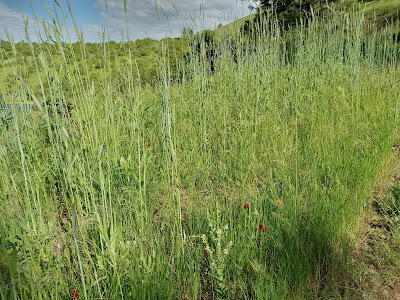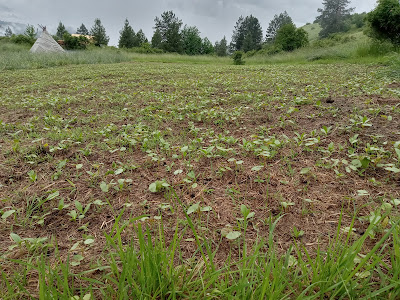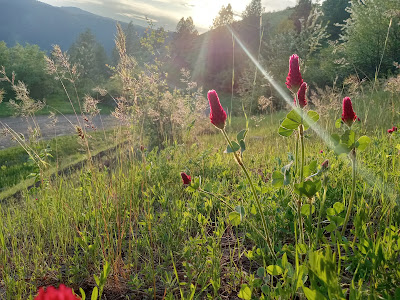One of my biggest challenges since purchasing my property has been to find the best way to establish a food plot. Because my property was once part of an active cattle operation the majority of it is covered in perennial cool season pasture grasses such as Meadow foxtail, Smooth brome and Kentucky bluegrass. This means the first step to transition a new plot into productive forage for wild game is to terminate these grasses and other weeds.
The problem with these grasses, however, is that they are extremely resilient and hard to kill. Once they take hold they spread through rhizomes and will eventually create a dense impenetrable sod that prevents other plants from establishing. They also are very tolerant of close grazing and mowing. Even if you continuously scalped them with a weedeater every few weeks during the growing season some would still hold on and if you stopped they would slowly but eventually make a comeback and spread back to their original sod bound state. I know this from personal experience. So this ultimately is not a viable option to terminate them.
Some other methods I've tried have been to use a shovel to flip the sod upside down to smother it. This was also unsuccessful because the roots would resprout even after being turned upside down and eventually would regrow through the upturned sod. This, like scalping with a weedeater, was a ton of backbreaking work, especially over a large area. So, in order to terminate the sod I had to come up with something different.
One option that would probably work, but that I wanted to avoid due to potential health hazards was the use of herbicides like glyphosate. While many people use chemicals like this to terminate pasture this was not a viable option for me because I am not comfortable using these potentially dangerous synthetic compounds in an area where my family, livestock and wild game would be frequenting. So at least for me my ideal sod termination method would have to be organic.
Another potential option would be to use a rototiller or similar equipment to turn over the soil and terminate the grass. However, this would probably take multiple applications. Ultimately I would like to avoid tillage as much as I can to protect the soil health. My ideal method would preferably be no-till.
After researching my potential options over the years I eventually came across the concept of Occultation. While searching online for methods to terminate grass I came across some people who were using black plastic tarps to kill lawn grass to establish gardens in their yards. This method used the opaqueness of the tarp to smother and starve the grass of sunlight, killing it over several months. This method was both organic and no-till and also was relatively easy and didn't take a lot of backbreaking work. The one major downside being that it takes a long time to take effect. For me, this was totally fine, as I had plenty of time to establish my food plots.
The more I thought about this process the more I realized how genius it was. In nature this is a very common way grasses die. As a meadow dominated by grasses gets invaded by shrubs and trees, they eventually block out the sun from reaching the grass and over time as the trees grow and their canopy covers more area the grasses cease the ability to photosynthesize. They eventually die out completely. This process in nature takes much longer than using a plastic tarp but the principle is the same. This is called occultation, which means to obscure from view.
When we occultate a pasture from the sun with a plastic tarp we are preventing the grass from photosynthesizing. Over time the grass will use up all of its roots' energy reserves trying to send up new shoots to intercept the sun's rays. This process can also be observed when something such as a stack of firewood is left on a lawn for too long and eventually you create a bare spot because the grass has been starved of sunlight.
In my opinion, this is the best way to establish a small food plot. It is both organic and no-till and is relatively easy and affordable.
In order to occultate an area of grass that you want to turn into a food plot you will have to first acquire an opaque plastic tarp. The most common type of tarp used for this purpose is a black silage tarp which can usually be purchased at farm supply stores. You can also sometimes find used ones for much cheaper or free from farmers who use them to make silage or to preserve haystacks.
Another option that may work is used vinyl billboard signs. These can be found online from companies trying to recycle them. For the establishment of a food plot you will likely want to try to find the largest ones you can get your hands on. The one I have been using for the past couple of years was bought new and is 40'x100'. I have moved this to a new spot every year to expand the area of my food plot. You can do this every year until your plot reaches it's desired size or you can acquire multiple tarps to fit the size of your plot.
Once you have your tarp you will generally want to put it down as soon as grass growth starts in the spring. For me this is usually early March. Also you will want to prepare the plot the year before by mowing the grass short and keeping it short for a full growing season to weaken the roots. This will allow the tarp to kill the grass quicker the following year. You also want to make sure there are no cut stalks of stiffer weeds that could poke through your tarp and create a hole. If you do get holes, which you probably will after several years of use, you can always patch them up with duct tape.
Once your plot is prepared and you're ready to put down your tarp you can unfold it and place it on the plot. Then once it is stretched out smooth you will need to weigh down the edges with stones or other objects to prevent wind from getting underneath and blowing it around. It's a good idea to check it every few weeks or so to make sure the wind hasn't moved it.
After securing the tarp onto your future food plot in the early spring you will want to leave it there for at least 4-5 months to get a complete kill of the sod. If you prepared the area properly the previous growing season by keeping the grass short, then you will probably be able to kill the grass quicker. I would not do any less than 4 months, with 5+ months being ideal for a complete kill.
Once your tarp has been sitting on your plot for the recommended amount of time then you can remove it and you will be left with the dead sod. At this point you are left with a blank slate and can plant a food plot using whatever method you prefer.
For me, if I'm planting a perennial food plot, I will frost seed over the winter or wait until early the following spring to broadcast my perennial mix. Then, I will use my chain harrow to rake in the seed to get good seed-to-soil contact. If waiting until spring to plant, you may get some winter annual weeds coming up in your plot, but harrowing can help remove them. Also while your tarp is down you will want to make sure that no grass is producing seed anywhere near the tarped plot back to a minimum of 15' away. If you don't do this then the grass seed can blow in and germinate once the tarp is removed and could be very difficult to control without starting over.
That is the rundown of my preferred method for establishing a new food plot on virgin ground that is dominated by grasses and other weeds. This method was developed after years of research and personal experience and I think it is the best one for smaller food plots where you want to protect the soil from chemicals and tillage.
For larger plots that you don't have years to create or the money to purchase all the necessary tarps then I believe tillage would probably be the next best option. While not ideal, because it can destroy the soil structure, this will recover over time as long as you are not repeating the tillage. A one-time till is a relatively safe option for a food plot establishment, in my opinion, although heavy weed pressure will usually be something that you will have to deal with.
So there it is. Hopefully this information can help you establish your new food plot and you can create some great forage to feed the wild game on the property you're managing along with help you improve your soil health.

















